Bitcoin Miners Face Tight Margins With Record Difficulty And Weakening Income
The Surge in Bitcoin’s Network Difficulty
Bitcoin’s network difficulty has reached an unprecedented high, surpassing 136 trillion. This is a significant challenge for miners who are already grappling with diminishing revenues. This latest adjustment, recorded at block height 913,248, represents a 4% increase from the previous level of 129.6 trillion. This marks the fifth consecutive rise since June, as noted by data from Mempool.
Understanding Network Difficulty
The difficulty adjustment mechanism is one of the core elements of Bitcoin’s design. Approximately every two weeks, or after 2,016 blocks are mined, the system recalibrates to ensure that blocks are produced at a stable rate—aiming for a target of one block every ten minutes. A rise in difficulty implies that more computational power has been added to the network, while a decrease indicates that some miners have exited. These adjustments play a crucial role in maintaining the stability of Bitcoin’s block creation.
The Financial Pressure on Miners
As network difficulty ramps up, Bitcoin miners are facing a particularly challenging environment. According to data from the Hashrate Index, the hashprice—the metric used to gauge miner revenue relative to their computational power—has fallen to approximately $51. This figure is the lowest seen since June and highlights the growing revenue pressures amid intensifying competition.

August’s data further illustrates this trend. The average hashprice during the month settled at $56.44, a decline of about 5% compared to July. Notably, Bitcoin’s transaction fees have provided little relief, further tightening the financial squeeze on miners.
The Decline in Transaction Fees
Statistics from Hashrate Index underscore how transaction fees have failed to bolster miners’ incomes. On average, miners received just 0.025 BTC per block, which corresponds to a staggering drop of 19.6% compared to July. In dollar terms, this resulted in an average daily fee income of $2,904—depicting a nearly 20% month-on-month decline and representing the lowest earnings since early 2013.
The Path Ahead for Miners
With the combination of soaring difficulty levels and falling revenues, Bitcoin miners find themselves in a precarious position. The path to maintaining profitability for the remainder of the year is fraught with challenges. Unless Bitcoin’s price sees a significant rise or increased on-chain activity generates more substantial fees, miners will likely operate under tight margins.
As they navigate these turbulent waters, the resilience and strategic planning of miners will be crucial in tackling the dual pressures of a hostile economic environment and stiff competition.



